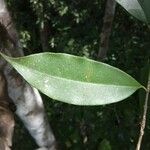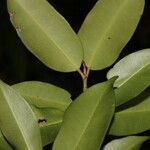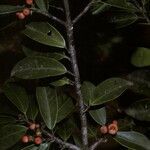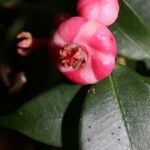Tree to 30 m tall; sometimes stilt-rooted; sap yellow. Leaves oblong to lan-ceolate, often slightly wider above the middle, apically acuminate, basally obtuse or acute, 4-6 cm long, 1.5-3 cm wide, the costa impressed above, elevated be-neath, the lateral nerves numerous, straight, parallel, slightly ascending, often abruptly forking near the margin to form an inconspicuous continuous submar-ginal vein, chartaceous, often slightly grayish; petiole short but distinct, 3-5 mm long. Inflorescence condensed and subumbellate, cymose peduncle mostly ob-solete but sometimes 2-3 cm long; bracts wanting; bracteoles obsolete; pedicels straight, ca. 1 cm long. Flowers depressed globose, pink or red, ca. 1.5 cm across; sepals 5, quincuncial, rotund, broader than long, ca. 5 mm long; petals rotund, ca. 10 mm long, imbricate, contorted; filaments exserted, forming a narrowly turbinoid column around the ovary, apically splitting into 5, white strap-like ele-ments, the anthers 3 per segment, linear, abaxial on the segments, dehiscing longitudinally by lateral slits; ovary 5-locular, turbinoid, produced into the style, the style apically divided into 5 porrect linear lobes which alternate with the anther connectives, white, stigmas minute, distal on the style lobes and directed downwards, minute. Fruit subglobose, 2-4 cm long, surmounted by the persistent style and branches, leathery, brownish or yellowish; seeds 1(-3), red, ellipsoid to subglobose.
A tree. It grows 15-30 m tall. The trunk is straight. The crown has short horizontal branches. The bark is smooth and dark brown. The branches have grooves along them. The leaves are leathery. The leaf blade is 5-12 cm long by 2-4 cm wide. It tapers to the tip and is wedge shaped at the base. Leaves are paler underneath. The flowers occur as many together. They are at the ends of short branches. The petals are bright red or yellow. The fruit is a berry 15-35 mm across. It is red but turns brown. It has 1-2 seeds. The seeds are 15-20 mm long and flattened.
Leaves coriaceous, petiolate; lamina 5–12 × 1·3–4 cm., oblong or elliptic to oblanceolate, acuminate at the apex, cuneate at the base, dark glossy green above, paler below, with numerous closely parallel lateral veins prominent below forming a wide angle with the midrib and branching and anastomosing towards the margin, and with dark glandular streaks or lines sometimes visible on the lower surface; petiole 5–15 (20) mm. long, channelled above.
Androecium of 2 whorls, the outer sterile, forming a ± pentagonal cupule 1·5–4 mm. high, with entire or undulate margins; the inner comprising 5 stamen-fascicles each with 3–4 completely united stamens, the fascicles united to form a membranous tube round the ovary, free above, spreading at anthesis; anthers 2–5 mm. long, linear, parallel, with connectives prolonged to form a short acute or bifid appendage.
Ovary ovoid; loculi (1) 2–4-ovulate; styles 1–2 times as long as the ovary, thick, fused together for c. 2/3 of their length, then spreading or recurved; stigmas minute.
Tree 15–30 m. (rarely to 36 m.) high, with straight bole and a crown of short horizontal branches; bark smooth, dark or reddish-brown.
Petals 7–15 mm. long, 5–6 times as long as the sepals, carnose, ± orbicular, scarlet or bright-or yellowish-red, deciduous.
Sepals unequal or subequal, ovate to orbicular, rounded at the apex, with margin entire or ciliolate.
Inflorescences corymbose or subumbellate many-flowered cymes, terminating short lateral branches.
Berry ovoid or globose, 15–35 mm. in diam., verrucose, red turning brown, 1–2 (rarely 3)-seeded.
Branches longitudinally grooved and slightly flattened when young, eventually cylindric.
A tree, up to 80 ft. high; bole straight with a crown of short horizontal branches
Flowers pedicellate; pedicels 12–25 mm. long, quadrangular above.
Flower-buds 6–12 mm. in diam., globose.
Seeds c. 15–20 mm. long, ± flattened.










